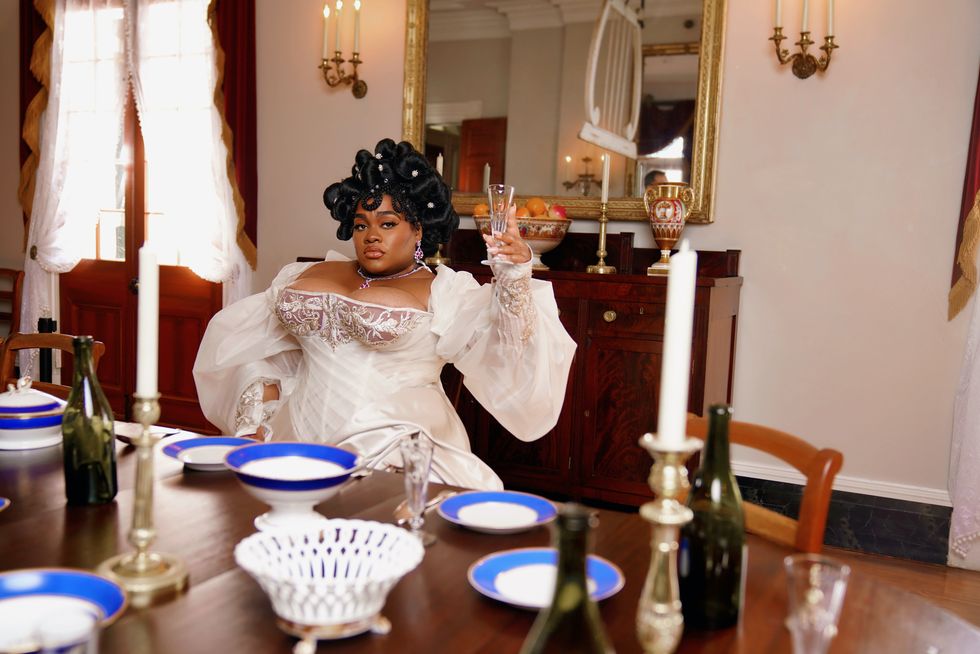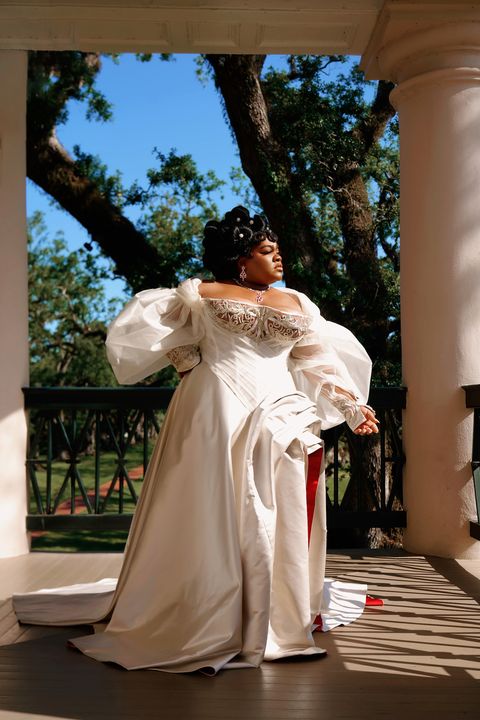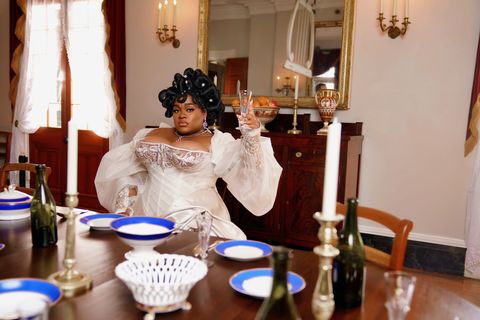What Da’Vine Joy Randolph Wants, She’ll Create
What Da’Vine Joy Randolph wore for the 2022 Met Gala was surprising for three reasons: One, she designed it herself. Two, her champagne-colored corset gown fit the “In America” theme better than the overwhelming majority of dresses that floated into the Metropolitan Museum of Art in May. And finally, three: She wasn’t invited to the Met Gala.
The actress—who won rapturous praise for her performances in 2019’s Dolemite Is My Name and 2020’s High Fidelity; just appeared in the season 2 finale of Only Murders in the Building this week; and is about to premiere On the Come Up at the Toronto International Film Festival—took the lack of summons as its own form of invitation. Working with the Los Angeles-based costume fashion designer Thomas Ogden, she envisioned a character and a look for that character, which Randolph described simply as, “If Hattie McDaniel’s character from Gone With the Wind had a seat at the table and was attending the Celebration Ball.”
She took pieces of pre-existing dresses online and cut and pasted them into a new look, with a sheer corset, a low V in the back, and a high slit. She mobilized a small workforce to orchestrate a photoshoot at the Oak Alley Plantation and Chalmette Battlefield, both in Louisiana. She inhaled pastoral paintings and works by Annie Leibowitz to envision the images she wanted to create with photographer Conrad Khalil. The resulting photoshoot, part of what Randolph describes as her “duty and obligation to continue to fight against their desire to erase us,” is being published for the first time on ELLE.com.
The amount of time and money Randolph poured into this project—especially given it had nothing to do with her numerous ongoing film and television roles—becomes less surprising when you understand her approach to her work. Every time she’s seen in public—whether onscreen or in photos—is an opportunity, a chance to break herself out of the archetypes so often thrust upon women of her race and her size, she says. Her passion for (and frustrations with) Hollywood quickly spill into her passion for (and frustrations with) fashion as we discuss her interests. To Randolph, they’re all part of the same system. For curvy Black women to be appreciated, they must be witnessed—in nuanced roles and in fabulous clothing.
Although she’s been an accomplished actress for more than a decade, recently, Randolph seems to be everywhere these days: red carpets, Only Murders, On the Come Up, the upcoming biopic Rustin, the upcoming HBO series The Idol. In a wide-ranging conversation with ELLE.com, the Tony Award-nominated actress laid out her thoughts on why she picks the projects she most desires—and why she has plans to launch her own fashion collection.
Every time I’m watching you as Detective Williams in Only Murders, it feels like I’m watching a window into a spinoff series. There’s so much there with this character: She’s a workaholic detective, a woman married to another woman, a new mother. She’s hilarious. She knows A Chorus Line!
It’s a real collaborative experience between John Hoffman, the showrunner, and with Steve Martin and Martin Short. They allow me to be playful with them and bring myself to this character, and so we do many different variations. We truly just play. It allows it also not to be stereotypical, right? Yes, she is a detective, but what I find interesting is how her personality is infused with her job, or because of her job, how she interacts with people or doesn’t interact [with them]. That, to me, is more interesting as opposed to, let’s say, a procedural cop drama.
Were you surprised by the ending this season?
I was surprised. But then I wasn’t, because having done season 1, and I said this to John: “Ah, okay. Even in the unknown, we’re still setting up a formula.”
What I really loved, personally, in this season was how— and I didn’t notice it until John had stated it—but the first season was Mabel’s season, in which we were looking into her life and seeing who she is and where she’s from, and there’s still a lot of stuff that we don’t know. And then this season was Steve’s season, and I was very moved by how they chose to go about doing it.
New York has a very specific thing where you can be around thousands of people and still feel alone, you know? I feel like this show picks up on it in such a interesting way. There’s all these characters that are interwoven, but at the same time, everyone has their own individual journey. Even when you think it’s dealt with and all’s said and done, it can always come back. And I’m thoroughly impressed by how the writing room is able to weave all these webs and keep all this stuff straight.
Honestly, [filming Only Murders in the Building] feels like going on a vacation. Every time they call my people and they’re like, “If she’s available, we would love to do another…” I’m always like, “Figure it out.” Because it’s the best creative vacation to take. It’s such a wonderful working environment.
Well then, I feel obliged to ask—where are you hoping to see Detective Williams pop up in season 3?
I think there’s a lovely B-story that I feel like is beginning to generate and percolate more and more. And I feel like we got a bit of that when she comes out of maternity leave to visit [Oliver and Charles in episode 7]. She’s vulnerable enough to be like, I don’t know what I’m doing [as a new parent.] And I’ve always had to know what I was doing. I’m used to being good at things. And now this, I’m not. And I miss my job and I want to work, and this is where I’m at in my life.
I think she’s learning how to be more than just her job, which I definitely can relate to. But she doesn’t know how to navigate that. [Charles and Oliver] had their careers, and, in many ways, want their careers back. So it’s like, [the characters] can glean from each other. That could be an interesting way for the show to potentially evolve, where you’re really understanding these people’s wants. But I think that’s what’s also beautiful about New York: that sense that we’re all on the beaten path, hustling and in our own worlds, but we’re all very much going through the same things.
What drew you to On the Come Up?
I’ll start off by saying that, when I was in graduate school, I was really intrigued by type and identity as an actor, right? Especially, I think, as a woman of color, I really was like, “Okay, well, when I graduate from here, what kind of actor am I going to be?” And my teacher said to me, “Watch the performances and actors and actresses that you enjoy and try to find a commonality in them.” And the thing that I came to understand, once I did that exercise, is that [my favorite performances] are transformational. The actor or actress constantly kept you on your toes, meaning they could literally go from playing a farm wife to then a Vegas showgirl.
So, that’s the thing I feel like I’ve been chasing and intrigued by. So I was filming the Bayard Rustin biopic [Rustin], playing Mahalia Jackson. I was literally on set in this, like, uber-auntie vibes. Church vibes. Like real Southern, and literally getting this call, and they were like, “Hey, so this role has come up for a drug dealer with a heart of gold, who’s butch.” While in costume, sitting in my trailer, I remember looking in the mirror and my body was buzzing. And I was like, “Yes.” It literally was like, I had to leave the next week. If I was going to do [On the Come Up], I was going to leave the next week. But I remember feeling like, To go from this extreme to that? Absolutely.
I think Sanaa Lathan is a wonderful actress, and then to hear that she was going to direct it, I was just really excited and intrigued. And it was cool because we both went to Yale for graduate school. So I was like, Okay, well, I know we’ll be speaking the same language.
When did you feel like you’d achieved that transformational quality with your On the Come Up character? When you were in costume?
I don’t know if it’s my personality or if it is—I don’t know—a theater background, I’m not sure. But even with red carpets, I am so detailed on what the character or my look on the red carpet is, because I want to tell the story and I want the story to be clear from the moment you see it.
The look hugely informs the character. And, for me, it helps me, because it allows me to get out of my pedantic, pedestrian, personal self, and dive into who this person is. So, we had so much fun of getting this character’s wardrobe. I went with a friend of mine here in Los Angeles, because we filmed in Atlanta, and I was like, “This isn’t the right clothes. It’s close, but it’s not quite it.” And so I came back to LA and I bought clothes here.
And we went back and forth with the hair and all that stuff, so that by the time I put on everything, I was there, you know what I mean? I was locked into the character.
Every role I choose, when I say yes to a role, it’s like me saying, I want to pay homage to this person. It’s like a love letter with that person. Because it’s me and them. So, it’s just exciting for me, especially, again, as a woman of color, because [Hollywood] tends to want to give us certain types of roles. I’m always of the mind of, “Yeah, let’s do something different.”
So, then, who’s the character in this photo shoot you designed? What’s the story?
I remember when they first announced what [the Met Gala theme] was, I immediately had a very strong, vivid image in my mind. Usually, when I get hit with inspiration hard—I don’t know, maybe it’s impulsive—but I’m the type of person where I’m like, Well, I have to do it now because I’m thinking about it too much.
I was staying in New Orleans at the time. We filmed at an actual plantation in Louisiana. The grounds, you could feel it. The moment you got there, we were like, Some things happened here.
I wanted to take back the idea of what it is to be a woman. What is the definition, to me, of America? To be really frank, being a curvy Black woman, I often play roles in which I’m in help to someone, in service to them. And that’s a beautiful thing. I’m also that in real life.
But what I have issue with is that, often, you don’t know anything about me. And that, to be really honest with you, happened with High Fidelity. And that’s why I think if we were to have had that second season, that was something that [the creators] were going to amend. I started noticing within the industry, a woman of size—and especially a woman of color of size—can be pigeonholed into a certain lane. But the ironic part is you look to that person. In TV and movies, you’re looking, thinking, “What is she going to say?” “Oh, I’m so interested in what she’s thinking.”
In being creative, I can take back my power and my identity and my representation. And so, for me, [this shoot] was a love letter to myself, a love letter to women who look like me. It was something in which I wanted people to know we are worthy and we can look just as beautiful. Some of the images, it was just magical the way it worked out. Now, looking back at those pictures, it’s like, Wow, it looks like she owns the house.
That was one of the things I loved most scrolling through them.
Every major red carpet, I look at those moments where it can be a world stage—where I know these photos will circulate—as a way to let these people know, This is possible and you could do it. Please don’t forget us.
The idea that curvy people don’t get invited to certain fashion events, or that there’s only one or two designers open to [designing for plus-size women]? So what are all these other women doing, who don’t have my bank account? Do they just have to sacrifice that part of themselves?
It feels like one of my missions in life. I don’t know why, but it really does. I just talked with my designer, Thomas Ogden, about what we wanted to design and create for the world premiere for On the Come Up at TIFF. And I got so excited because I think of a character. I think of a woman, of telling a story. And I find when you get specific, people get it. They catch onto it.
I really feel a mission, a responsibility and a kinship to curvy women—of them having what they need. So down the line, the very near future, a collection is definitely in the works. There’s a handful of [clothing] labels, but everyone—
It’s extremely limiting.
Everyone is wearing [the same] stuff. I’m an actress, so I’m supposed to be showing you the new stuff. That’s how I ended up going the route of custom. I was at a premiere for something and a curvy reporter had on the same outfit as me. It’s not like, She shouldn’t have had that on. But it didn’t make me feel like I did my job. You know what I mean? I’m an entertainer, and I didn’t take it to the level that I should have. I came to terms with, “Well, this is all you have, so you’re going to have to create it.” But I feel like that’s been like my mantra of life.
Just by someone viewing these pictures, I hope that it impacts people, it motivates them, it gets them thinking or wondering of, Oh, wow, someone is worth putting that time and effort in to create something.
I know it will happen: the day where the majority of designers will have a true split 50/50 runway [in terms of size diversity]. It won’t just be, you know, Precious Lee and Ashley Graham who, at some point in the runway, pop in. The exciting part is, Da’Vine, there’s a lane, so create it. I care so much about people and I try to use my gifts to be of service to people, because I believe that’s why we’re put here. We all have a purpose here on earth. And ultimately that purpose is to serve others, whatever your gift is.
This interview has been edited and condensed for clarity.
Photographed by Conrad Khalil. Dress designed by Thomas E. Ogden. Makeup by Cherie Cook. Hair by Shannon Bakeman.
Lauren Puckett-Pope is an associate editor at ELLE, where she covers news and culture.





